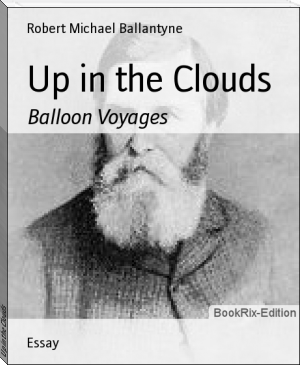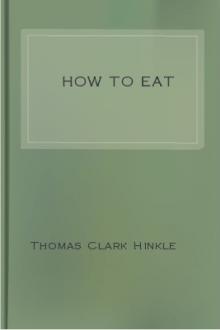Up in the Clouds by Robert Michael Ballantyne (most important books to read txt) 📖

- Author: Robert Michael Ballantyne
Book online «Up in the Clouds by Robert Michael Ballantyne (most important books to read txt) 📖». Author Robert Michael Ballantyne
Well might they gaze in breathless expectation! After floating for some time in the upper regions of the air, as if he dreaded to make the bold attempt, he cut the cord that fastened him to the balloon when at the height, probably, of about half a mile. At first the parachute remained closed and descended with frightful violence; then it burst open, and for some seconds tossed about to such an extent that the basket was sometimes thrown almost into a horizontal position. The wind carried it over Marylebone and Somerstown; it almost grazed some of the houses of Saint Pancras in passing, and finally came to the ground in a field with such violence that poor Garnerin was thrown on his face and severely cut and bruised. No wonder that we are told he received a terrible shock. He trembled violently, and blood flowed from his nose and ears. Nevertheless, the accident did not deter his daughter from afterwards making the descent several times--and in safety.
The cause of the irregularity and violence of Garnerin's descent was the giving way of one of the stays, which had the effect of deranging the balance of the apparatus.
In 1837 Mr Cocking invented a new parachute, which he hoped would be free from the faults of the other. It may be described as being the reverse of that of Garnerin, being made in the form of an umbrella blown inside out. The resistance to the air, it was thought, would be sufficient to check the rapid descent, while its form would prevent the tendency to oscillate.
This parachute was 34 feet in diameter, and was distended by a strong hoop to prevent its closing. There was also a hole in the middle of it, about 6 feet in diameter. Mr Cocking started from Vauxhall Gardens on the 24th of July, and after ascending to a considerable height, cut himself loose from his balloon when over Blackheath. The parachute descended rapidly, and vibrated with great violence; the large hoop broke, the machine collapsed, and the unfortunate aeronaut was killed, and his body dreadfully mutilated.
Fatal accidents of this kind were to be expected; nevertheless it is a fact that the disasters which have befallen aeronauts have been comparatively few, considering the extreme danger to which they are necessarily exposed, not only from the delicacy of the materials, with which they operate, and the uncertainty of the medium through which they move, but, particularly, because of the impossibility of giving direction to their air-ships, or to arrest their progress through space. Parachutes, however, are not so absolutely incapable of being directed as are balloons. Monsieur Nadar writes on this point as follows:--
"Let us consider the action of the parachute.
"A parachute is a sort of umbrella, in which the handle is replaced at its point of insertion by an opening intended to ease the excess of air, in order to avoid the strong oscillations, chiefly at the moment at which it is first expanded. Cords, departing symmetrically from divers points of the circumference, meet concentrically at the basket in which is the aeronaut. Above this basket, and at the entrance of the folded parachute, that is to say, closed during the rise, a hoop of sufficient diameter is intended to facilitate, at the moment of the fall, the entrance of the air which, rushing in under the pressure, expands the folds more easily and rapidly.
"Now the parachute, where the weight of the car, of the attaching cords, and the wrigglings of the aeronaut, is in equilibrium with the expansion--the parachute, which seems to have no other aim but to moderate the shock in falling--the parachute even has been found capable of being directed, and aeronauts who have practised it, take care not to forget it. If the current is about to drive the aeronaut over a place where the descent is dangerous--say a river, a town, or a forest--the aeronaut perceiving to his right, let us suppose, a piece of ground suitable for his purpose, pulls at the cords which surround the right side, and by thus imparting a greater obliquity to his roof of silk, glides through the air, which it cleaves obliquely, towards the desired spot. Every descent, in fact, is determined by the side on which the incline is greatest."
That these are not mere theoretical opinions or conjectures is certain from the fact that Mademoiselle Garnerin once wagered to guide herself with a parachute from the point of separation from her balloon to a place determined and very remote. By the combined inclinations which could be given to her parachute, she was seen in fact, very distinctly, to manoeuvre and tend towards the appointed place, and succeeded at length in alighting within a few yards of it.
CHAPTER SIX.
ASCENTS BY MESSRS. GLAISHER AND COXWELL.
We now come to that point in our subject where it is appropriate to give more detailed and graphic accounts of the recent doings of aeronauts. An extremely interesting description of a scientific balloon ascent is given by the celebrated aeronaut, Mr Glaisher, in a pamphlet, from which we shall make a few extracts. [See Note 1.] His description is illustrative of the subject of ballooning, and contains the salient points of several ascents.
He asks us to imagine the balloon somewhat more than half inflated, eager for flight, with only one link connecting it with earth, namely, a rope attached to an instrument, called a liberating iron catch. When all the ballast, instruments, etcetera, were placed in the car, Mr Coxwell brought the balloon to a _nice_ and _even_ balance, so that the addition of twenty pounds would have prevented it from rising.
As the moment for departure drew near, friends became impatient, and every one anxiously watched the final arrangements, which were made by Mr Coxwell, on whom was laid the important duty of _letting go_. His hand was on the catch, his countenance was fixed, and his expression stern, as he gazed up into the heavens. He was waiting for the right moment, for the sky was partially cloudy, and it was necessary to wait until the balloon was midway between the cloud that had just passed and the next that was approaching, so that the aeronauts might have a clear sky, and be able to see the earth they were about to quit for a time. Nor was this all; he knew that in every wind, however strong it might be, there are periods of calm. If he could start in one of these he would avoid much rotatory motion. The deciding, therefore, of the exact moment for making a fair start was not so easy a matter as one might suppose.
Some one at this critical time, with the characteristic eagerness of poor human nature to "put its finger in the pie," cried out "Now!" and another shouted "Pull!" but Mr Coxwell, regardless of every one, decided for himself; and, just when the wind lulled and the sun shone bright, and the balloon stood proudly erect, he pulled the trigger and they were free.
But they were more than free. They were suddenly in profound repose, for--however high the wind may be, however agitated the balloon, swaying to and fro with sudden and violent action, despite the efforts of many hands that endeavour to restrain it,--no sooner do aeronauts quit their hold of earth, than, in an instant, all agitation ceases and they are in perfect stillness, without any sense of motion whatever; and this freedom continues throughout the entire flight--except, indeed, when they sink so low as to come into contact with mother earth, when the serenity of their flight is terribly and violently interrupted, as shall be seen in the case of another balloon voyage hereafter to be described.
They were now fairly away, but we pause to remark, before joining them in their voyage, that their object on this occasion was not merely amusement--scientific investigation and experiment were their aim. In order that the reader may have some idea of the nature of such, we subjoin Mr Glaisher's list of the objects of his experiments:
The primary objects were, he says, "to determine, at various heights, up to five miles--first, the pressure of the atmosphere; _second_, the temperature of the air; _third_, the hygrometrical (or moist-measured) states of the air."
The secondary objects were:
"To compare the readings of an aneroid barometer with those of a mercurial barometer, up to five miles.
"To determine the electrical state of the air.
"To determine the oxygenic state of the atmosphere by means of ozone papers.
"To determine the time of vibration of a magnet on the earth, and at different distances from it.
"To determine the temperature of the dew point by Daniell's dew point hygrometer and Regnault's condensing hygrometer, and by the use of the dry and wet bulb thermometers, as ordinarily used, and their use when under the influence of the aspirator, causing considerable volumes of air to pass over both their bulbs, at different elevations, as high as possible, but particularly up to heights where man may be resident, or where troops may be located, as in the high table-lands and plains of India; with the view of ascertaining what confidence may be placed in the use of the dry and wet bulb thermometers at those elevations, by comparison with Daniell's and Regnault's hygrometers; and also to compare the results as found by the two hygrometers together.
"To collect air at different elevations.
"To note the height and kind of clouds, their density and thickness at different elevations.
"To determine the rate and direction of different currents in the atmosphere if possible.
"To make observations on sound.
"To note atmospherical phenomena in general, and to make general observations."
With these objects in view the aeronauts left _terra firma_ and soared into the skies.
"Once away," says Mr Glaisher, "we are both immediately at work; we have no time for graceful acknowledgments to cheering friends. Mr Coxwell must put the car in order, and accordingly looks to it, to his balloon, and to the course we are taking; and I must get my instruments in order, and without delay place them in their situations, adjust them, and take a reading as soon as possible.
"In a few minutes we are from 1000 to 2000 feet high. Mr Coxwell looks intently upwards to see how the huge folds of the balloon fill into the netting. If we have started from a town, we now hear its busy hum, and the now fast fading cheers of our assembled friends naturally attract our attention. We behold at a glance the quickly-diminishing forms of the objects which we so lately left, and then resume our work.
"Presently Mr Coxwell, who is always alive to the beauties of the ever-varying scene below, and to the opening landscape, fixes his eye upon me, and, just when a rural scene of surpassing beauty is lighted up in the west, he summons me to look and admire. I struggle against picturesque temptations, somewhat at variance with my duties, but cannot so quickly suppress them. A fine cloud rears its Alpine cap in close proximity to the car; Mr Coxwell looks as delighted as an artist when he displays a magnificent painting. I feel I must conquer such





Comments (0)